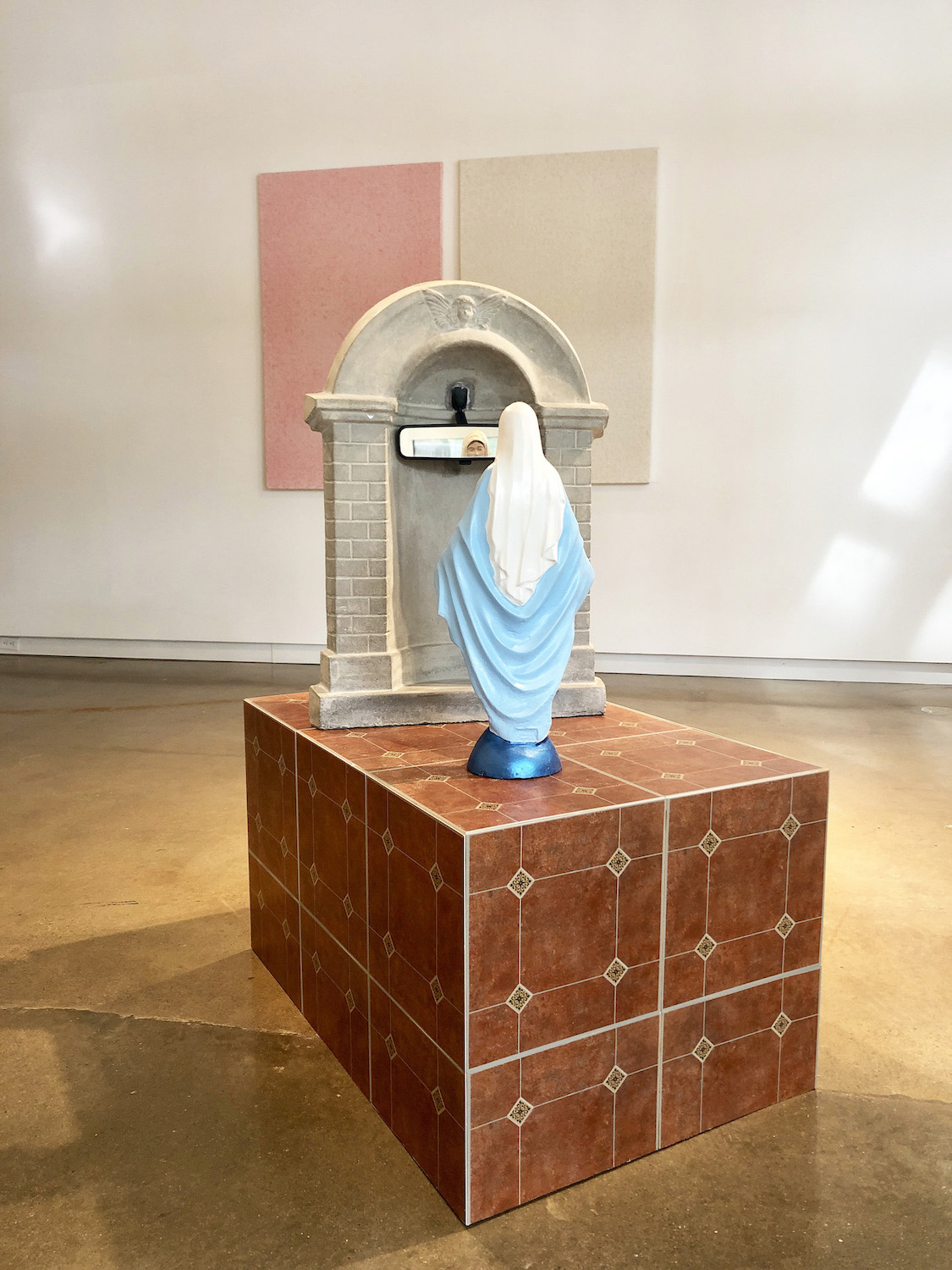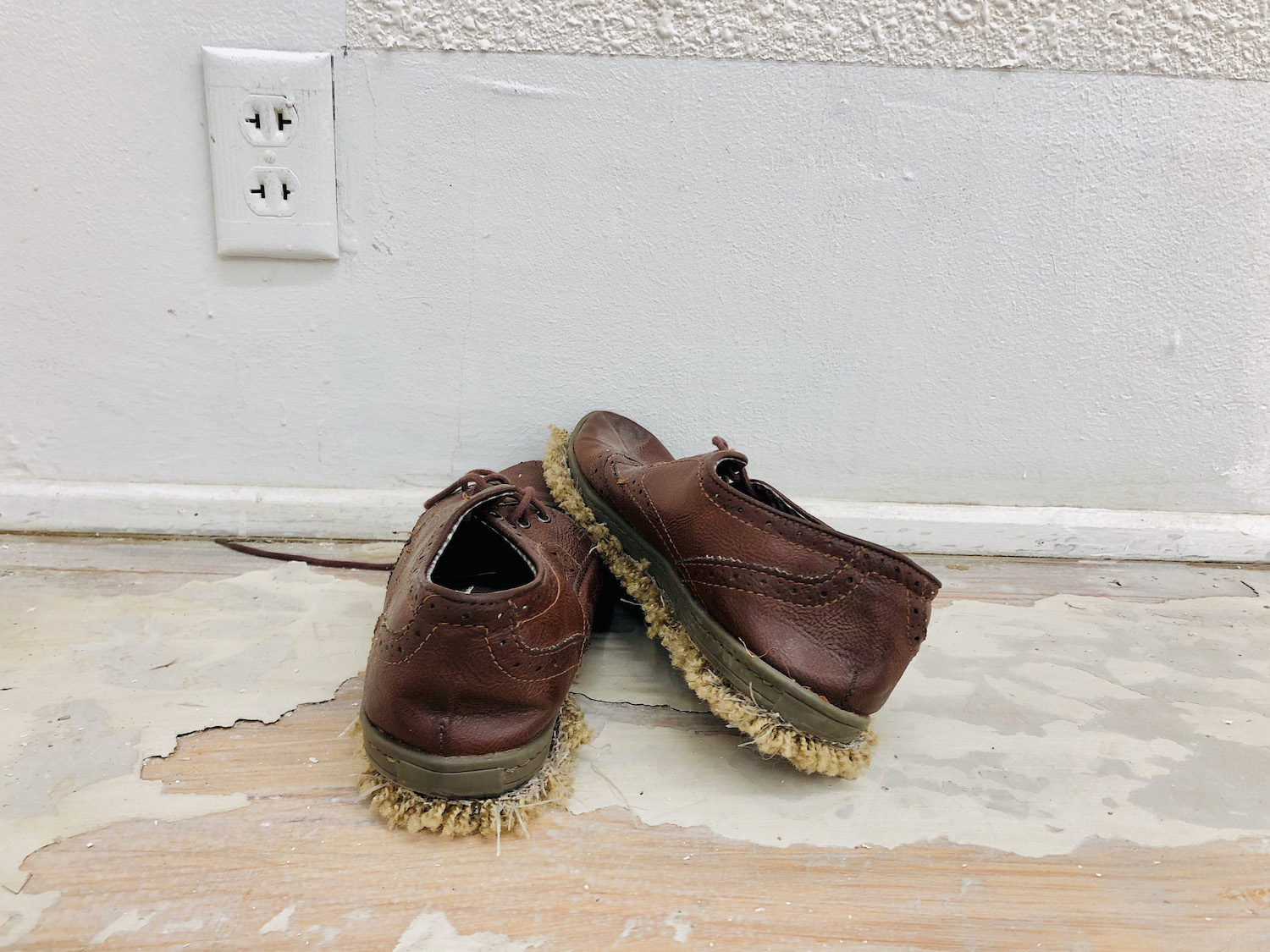I was thoroughly bewildered when I first saw Hector A. Ramirez’ work as a member of his MFA committee at Texas Christian University in 2017. He handed me Carpet Shoes, a worn pair of men’s brown leather shoes with rectangles of yellowish carpet glued to their soles such that their footprints would be made by the carpet’s fibers. This simple juxtaposition of two familiar objects creates an irreconcilable absurdity.
Art-historically, the distinction between Dada and surrealist assemblage is illuminating; Duchamp’s bicycle wheel attached to the seat of a wooden stool resists narrative closure and remains absurd while Man Ray’s Cadeau (1921), with large tacks attached to the pressing surface of an iron, evokes an image of clothing torn by the iron’s thorny sole. As in Bicycle Wheel (1913), the juxtaposition of everyday materials is also seen in Italian Arte Povera, which Ramirez acknowledges as an important influence. Giovanni Anselmo’s 1968 Untitled (Sculpture that Eats Itself), for example, consists of a rectangular pillar of polished granite wrapped with a copper wire that binds a leaf of fresh green lettuce to one side of the pillar.
Carpet Shoes straddles the borderline between sense and nonsense; one imagines the shoes’ wearer abjectly polishing a hardwood floor as he traverses it. Yet Ramirez’ own inspiration for the work was a documentary report on identically outfitted shoes handcrafted by migrants and drug traffickers to conceal their footprints from the authorities while crossing the desert. None of these explanations, however, fully account for the comic absurdity of Carpet Shoes on a pedestal in an art gallery.
Like Carpet Shoes, Ramirez’ found-object sculptures incorporate minimally altered and shrewdly juxtaposed objects from our everyday world, which are in conjunction conceptually and socially meaningful. Ramirez’ works recall Duchamp’s defense of the readymade urinal Fountain (1917) by “R. Mutt,” who “created a new thought for that object.”

Toma Agua, Ve a la Misa (Drink Water, Go to Mass), 2020; vinyl tile, cast concrete, glass mirror, 3 x 2 x 3 feet.
Focused on Mexican-American culture, Ramirez’ work is often drawn from memories of his childhood and family life in El Paso, Texas. A cast concrete Madonna and niche—designed to decorate his neighbors’ gardens—sit atop a base covered with printed vinyl tiles, common in middle and working-class homes. With her robe painted an appropriate blue by Ramirez, the Madonna faces the interior of her unpainted niche in which a rearview mirror is mounted at her head height. Titled with an aphorism of his mother’s, Toma Agua, Ve a la Misa (“Drink Water, Go to Mass”), the altar-like configuration is undone by the blasphemous suggestion of the Virgin’s vanity. The rearview mirror also evokes the car culture enjoyed by Latino youths.
A large floor-bound assemblage with sound, Ramirez’ Playing the Smiths Out of It (2020) includes an oversized homemade speaker cabinet, destined for the trunk of a car where it would emit the booming music favored by young men. The upright cabinet, however, is wrapped with thick sheets of mattress foam tied with wire. The configuration is reminiscent of nothing so much as Anselmo’s Untitled (Sculpture that Eats Itself), with the foam rubber replacing the lettuce leaf. The Smiths’ music, which is overwhelmingly popular with young Latinos, appears to be suppressed by the sound-muffling mattress foam. Ironically, their music is amplified by a small stereo component placed a few feet away on the floor.

Dócil, 2019, Construction materials 31 x 30 x 36 inches.
Dócil (2019) includes only two major readymade elements. Ramirez painted the sides of a small plastic doghouse a bright yellow and the roof a purplish blue, intending to recall the saturated hues often seen on the exteriors of Mexican-American homes. Inside the doghouse is a small toy dog, manufactured as a soothing “therapy dog” for elderly and Alzheimer’s patients. The fur-covered mechanized dog makes subtle movements and sounds. Upon bending down to view the work on the floor, the viewer’s presumption of a static assemblage—a dog in a doghouse—is shattered by the haunting, nearly imperceptible movements of the toy dog.
Ramirez painted the interior walls of the doghouse with a generic domestic hue mixed with texture additives familiar to any home- or apartment-renter (from sandy walls to popcorn ceilings). Because Ramirez’ father is a professional house painter, he has long been familiar with texture paint additives and in 2018 began to explore the critical possibilities of the material’s cultural implications. Adding various textures to beige and off-white paint, Ramirez sprayed large, neatly taped-off rectangles directly on gallery walls, at once recalling the high modernism of Robert Ryman’s white monochromes, the political implications of Diego Rivera’s proletarian murals, and the non-aesthetic production of hired house painters. His recent paintings on canvas are sprayed with textured layers of blues, pinks and yellows derived from snapshots of El Paso sunsets. They range from purplish gray to sienna monochromes. On close inspection, the various sprayed colors are visible on the sides of the small nodules projecting from the impasto surface.

Blue Waltz [video still], 2018; 2:07 minutes.
In addition to sculptures and tableaux, Ramirez produces low-tech videos. In Blue Waltz (2018), the intertwined, blue-jean clad lower legs and cowboy boots of two male dancers engage in the graceful steps and twirls of a country-music waltz. Although the dancers’ uniforms stereotype them as straight southwestern men, their physical intimacy exposes the macho superficialities of American and Mexican-American fashion and proposes another kind of cultural fraternity.
Ramirez’ work hones in on the subject of identity coursing through contemporary art since the 1990s. Like most identity art, his work is narrative and illustrative, based on personal and cultural memories. It is not however autobiographical, transcending the particular through its mundane humor and the tactile, anti-illusionistic presence of plastic, concrete and foam rubber. The real components of every assemblage speak the language of the industrialized world, from a culturally informed point of view.


